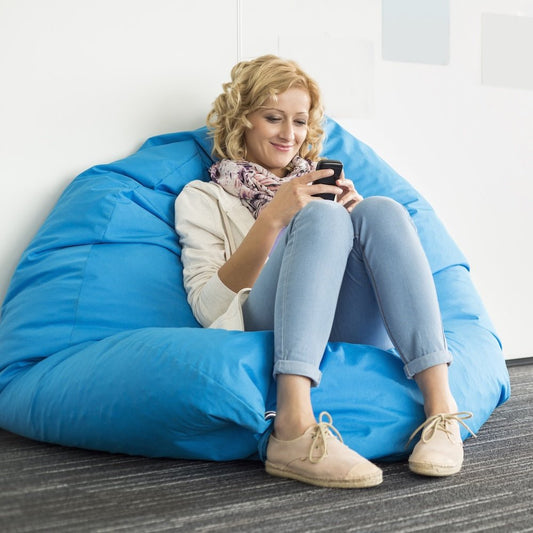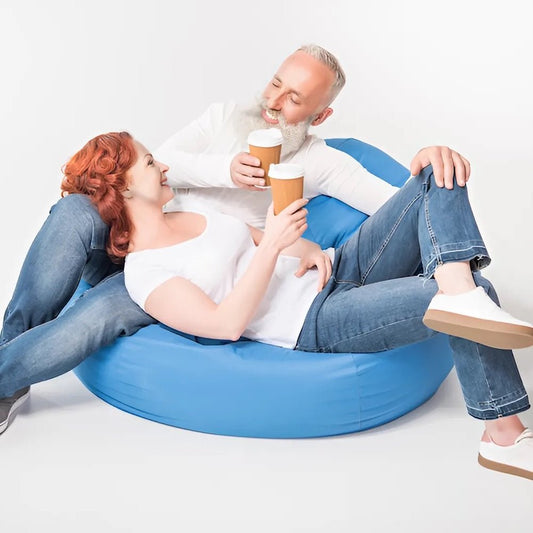There's nothing quite as relaxing as lounging around in beautiful weather on comfortable outdoor furniture. Quality outdoor furniture brings all the comfort of home while allowing you to enjoy the beauty of the great outdoors. But unlike other types of furniture, outdoor furniture doesn't just need to be comfortable and look nice. It needs to be able to stand up against rainstorms, scorching sunlight, and anything else nature throws at it. Fortunately, there are many ways you can keep your outdoor furniture in good condition season after season. Read on to learn the best way to care for your outdoor furniture cushions and accessories.
Protecting Outdoor Fabric
Outdoor furniture cushions come in many different types of fabric, so it's important to find the right one for your needs. Some of the most common materials for outdoor seat cushions include acrylic, PU-coated polyester, cotton canvas, and olefin. Most types of outdoor fabrics undergo special treatments to make them resistant to water, UV rays, and mould and mildew. While these treatments make outdoor cushions more durable, they aren't indestructible and can still be affected by the elements. Here are a few ways you can protect your patio furniture.
Sun Protection
While most outdoor furniture is designed to resist UV rays, too much sun exposure can fade fabric over time. The sun can also weaken wood and plastic furniture frames. There are several ways to protect your furniture from the damaging effects of the sun. The simplest is to just move your outdoor furniture to a shady or covered area when not in use. You can also use a spray-on fabric guard to help prevent your cushions from fading.
Rain and Snow Protection
Water-resistant fabric is designed to keep most moisture at bay, but leaving your outdoor furniture out in the rain all the time will cause wear. Water-resistant isn't the same as waterproof, so moisture can get into your cushions if they're often saturated and not allowed to dry thoroughly. Cover your patio furniture beforehand if wet weather is expected. If cushions are left out in the rain or snow, be sure to shake off all the excess water as soon as possible. Then leave them out to air dry completely. Allowing moisture to sit in the fabric can cause mould and mildew to grow. Even fabric that has undergone antimicrobial treatment can develop mould if left in a damp environment for too long.
How to Clean Your Outdoor Furniture Cushions
Different types of outdoor fabric require different cleaning approaches. Before you begin, it's important to refer to the manufacturer's care instructions. You can usually find this information on the product's tag or on the company's website. Many types of outdoor furniture can be cleaned effectively with mild soap and water. Read on to learn the most effective step-by-step approach to cleaning outdoor cushions.
Remove Surface Debris
The first step in cleaning your patio cushions is to remove all the debris on the surface. This means all the dirt, dust, leaves, and other muck that accumulates over time. You can use a soft brush or a vacuum cleaner with an upholstery attachment. For more stubborn dirt, use a wet cloth to scrub it out of the material.
Washing Outdoor Fabric
Although outdoor furniture is designed to be resilient, it will still benefit from a good washing every so often. Some types of outdoor cushions can be machine washed, but not all can. Refer to the care instructions to avoid damaging your cushion. Check out our article on how to protect outdoor furniture from the weather.
Use Mild Soap
Most types of outdoor fabrics can be washed with mild soap and water. You can either submerge the cushion completely or scrub difficult spots with a rag or sponge. For really set-in spots, allow the soap and water to soak in before trying to scrub it out. Repeat this as needed.
Dry Thoroughly
Be sure the cushions dry completely after washing. You can remove most of the excess water with a towel or a hairdryer, then leave the cushions out to air dry in a sunny place, if possible. Drying your outdoor cushions thoroughly after washing is essential for preventing mould and mildew.
Removable Covers and Liners
Outdoor cushions with removable covers and liners are very easy to clean. They can often be machine washed, and they help to protect the interior of the cushion from dirt and moisture. You can machine wash removable covers with mild laundry detergent and cool or cold water. Either allow them to air dry or tumble dry on a low setting, depending on the fabric and the care instructions. To wash your cover by hand, use 1/4 cup of dish soap and 1 gallon of warm water. Rinse out the soap thoroughly and allow the cushion to air dry.
Cleaning Mould and Mildew
Even outdoor cushions with antimicrobial fabrics can be susceptible to mould and mildew if they are allowed to remain wet for too long. Any signs of mould and mildew should be cleaned immediately. Mould and mildew have a very unpleasant smell, and the spores are unhealthy to breathe in or touch. Learn how to remove mould from fabric.
Bleach
Mould and mildew can be removed with a solution made of one part bleach, one part water, and two parts mild laundry soap. Scrub the cushion with a sponge to remove the mould or mildew and then rinse and dry completely. Be careful when using bleach on your furniture, and only use it in a well-ventilated area. Make sure to test the solution on a small patch of the material before using it on the whole cushion. This will avoid discolouring or damaging the fabric.
Borax
If you prefer to avoid using bleach, you can use borax instead. Borax is a good cleaning alternative for fabrics that can't be cleaned with bleach. It's also less harsh and doesn't have strong fumes.
Use Caution
Always use caution when working with mould, mildew, and cleaning chemicals. Wear gloves, goggles, and a safety mask for protection. Make sure there are no children or pets in the area.
Caring For Other Outdoor Furniture
Outdoor ottomans and furniture with cushions often also have frames made of other materials. These pieces need maintenance to keep your patio furniture at its best. Here are some tips on how to care for metal, wood, and plastic outdoor furniture.
Metal Frames
Patio furniture with a metal frame is sturdy and reliable, but it still needs regular maintenance. To get rid of dirt and grime, metal furniture can be cleaned with soap and water as needed. To remove problems like rust stains and mould, use a wire brush or fine-grit sandpaper. Touch up the paint in places where it's worn away, or give the whole piece a fresh coat every few years.
Wood Frames
Wood frames are strong, but they need a gentle approach for cleaning. Use a mild, oil-based soap to remove grime. Don't use a pressure washer to rinse, as this can cause gouges in the wood. Try to keep your wood furniture as dry as possible, as too much moisture can cause it to rot. You can apply a wood oil every so often for added protection from the elements.
Plastic Frames
Plastic furniture is lightweight and durable. You can just wipe it down from time to time with a sponge and gentle soap. In order to remove stains, you can use dishwasher detergent on white plastic to make it look like new. You can clean coloured plastic with a mixture of white vinegar and water.
Patio Umbrellas
Patio umbrellas require regular attention, too. Every so often, you should clean off dirt and debris with a rag or vacuum. Not only will this help keep the umbrella looking neat, but it will prevent it from being weighed down and sagging over time. If possible, remove the umbrella fabric to wash it. Machine wash the fabric or wash it by hand according to the care instructions. If the fabric can't be removed, scrub the fabric with mild soap and water. Clean the umbrella stand with the appropriate method for whatever material its made of.
Storing Your Outdoor Furniture
You can make your outdoor furniture last longer by storing it whenever it's not in use. Some good ways to store outdoor furniture include covering it with a protective tarp or placing it in a sheltered place, like a basement, shed, or garage. Wherever you choose to store your furniture, make sure it's a dry environment that's free of pests. If you place your cushions in plastic storage bags, make sure they have ventilation holes. This will allow air to get in while keeping moisture, insects, and rodents out. Proper airflow will help prevent the growth of mould and mildew. It can be a good idea to give your outdoor furniture a good cleaning before putting it in storage. This will help make sure the past season's stains won't set in. However, if you do wash your furniture, make sure it's completely dry before putting it away.
Maintaining Outdoor Furniture
One of the easiest ways to keep outdoor furniture looking its best for seasons to come is to keep up with simple daily maintenance. Here are a few small things you can do to make a big difference in the longevity of your outdoor furniture.
Keep Surfaces Clear of Dirt
Regularly brush away any debris that appears on your outdoor cushions. You can do this with a soft rag, brush, or vacuum cleaner. Not only will this keep your furniture more hygienic, but it will also help prevent dirt from setting in overtime. The more you keep up with surface dirt, the less often you'll have to give your cushions a deep clean.
Take Care of Spots ASAP
Be sure to treat any spots and spills immediately after they happen. This will help prevent them from permanently staining the fabric. You can treat most spills by removing them with a wet cloth and mild soap. However, certain types of stains and fabrics will require special care to remove. This is especially important for food and drink spills. Spilled snacks or soda can attract bugs and cause mould and mildew to form.
Check the Water-Repellant Coating
Some water-repellant coatings will break down over time. This leaves your cushions susceptible to mould and mildew. Check your outdoor cushions to be sure water beads on the surface. If it doesn't, you may need to refresh your water-resistant coating. There are many spray-on varieties of water-resistant coatings to choose from. Check the manufacturer's instructions to find out which one is best for the type of fabric.
Shade and Shelter
And of course, protect your furniture from the weather whenever possible. Move your outdoor seating to a shady place if it's left out on a particularly bright day. Cover it or move it into a sheltered area if you expect rain.
Regular Cleaning
Even if your cushions don't look dirty, it's a good idea to give them a thorough cleaning at least once a season. This will help you stay one step ahead of big problems like mould and insects. Keeping up with these tips will help preserve your outdoor furniture for the long run.
Kick Back and Relax with Comfy Outdoor Furniture
You can keep your outdoor furniture cushions looking and feeling great with these simple care tips. By doing just a little regular maintenance, you're free to kick back and enjoy the great outdoors in comfort and style. Interested in adding to your patio furniture collection? Check out our line of cool and comfortable outdoor bean bag chairs.




